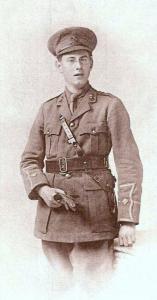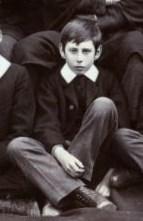
|

|
| Captain Charles Wydham WYNNE | |
|
182nd Siege Battery, Royal Garrison Artillery Date of birth: 29th May 1895 Date of death: 24th June 1917 Died of wounds aged 22 Buried at Longuenesse (St Omer) Souvenir Cemetery Plot IV Row C Grave 38 |

|
| Charles Wydham Wynne was born at Rathdrum in Ireland on the 29th of May 1895 the second and youngest son of Albert Augustus Wynne, a civil engineer, and Alice Katherine (nee Wynne) Wynne of Tigroney, Avoca, County Wicklow. He was educated at Lancing College where he won a Mathematical Exhibition and was in Seconds House from May 1908 to July 1913. In October 1913 he entered Balliol College Oxford where he won the Williams Mathematics Exhibition. In September 1914 he joined the University Officer Training Corps and spent the following term in mainly military work. On the 3rd of December 1914 he applied for a commission, requesting either the Royal Engineers or the Royal Artillery and on the 28th of February 1915 he was commissioned as a 2nd Lieutenant in the Royal Garrison Artillery. At his medical examination it was recorded that he was 5 feet 6/2 inches tall and weighted 127lbs. It was also recorded that he had poor eyesight and wore glasses. He was sent for training in Ireland with 15 Company, Royal Garrison Artillery. On the 6th of January 1916 a medical board was convened at the King George V Hospital in Dublin which determined that he had chronic appendicitis and would require an operation. On the 22nd of March 1916 a medical board sat at the Military Hospital Londonderry which concluded that he was not well enough to return to service and that he should be granted leave. On the 16th of May 1916 a medical board sitting at the Military Hospital Londonderry concluded that he was fit to return to general service. In June 1916 he applied to join the Royal Flying Corps but was turned down on account of his poor eyesight. He embarked for overseas service with the 182nd Siege Battery at Southampton on the 29th of September 1916, landing at Le Havre the following day. He was promoted to Acting Captain on the 25th of September 1916 while he was second in command of the Battery. On the 9th of October he was sent to hospital in the field and rejoined his unit on the 11th of October. He saw action at the Battle of Arras in where he was wounded on the 24th of April 1917 and was evacuated to No. 24 Casualty Clearing Station, returning to his unit on the 1st of June. He was wounded on the 10th of June 1917 at Armentieres and was evacuated to No. 5 Casualty Clearing Station suffering from multiple injuries including a fractured spine. His parents received a telegram dated the 11th of June 1917:- "Regret to inform you Capt. C. W. Wynne RGA 182 Siege Battery reported by 5th Casualty Clearing Station June eleventh dangerously wounded gunshot wound chest and arm. Further news sent when received." He was admitted to No. 7 General Hospital at St Omer on the 14th of June where he was described as being "dangerously ill". In a telegram dated the 16th of June his mother was granted permission to visit him in hospital but as she was 70 years old and his father was 84 it was decided by the family that they would both be too frail to make the journey. A family friend wrote to the War Office seeking permission for his sister to visit but they were overtaken by events. He died at No. 7 General Hospital at St Omer at 11.40 pm on the 24th of June and his parents received the following telegram:- "Deeply regret to inform you. Hospital reports Captain C. W. Wynne RGA 182 Siege Battery died of wounds June twenty fourth. The Army Council express their sympathy." A brother officer wrote:- “He was one of the best. Beloved by his men, an excellent officer, with a tremendous interest and wholeheartedness in our work.” A Private wrote:- “You will understand what a high opinion we all had of him and now that he is no longer with us we realise of what irreplaceable value he was, and would give all we know to have him with us again.” The Balliol memorial book said:- “In his short life at College he had shown great brightness and promise, and his rather spare figure covered no little energy of mind and body”. He is commemorated on the war memorial at Balliol College Oxford. |
|
 | |
| Seconds House |
Back